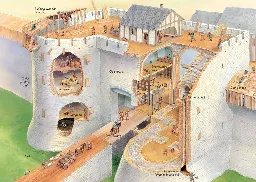I was gonna comment on being the poor sob who has to haul grain up, and flour back down all those stairs.
But then I remembered the Romans had slaves…
The Romans had some really ingenious devices for lifting large loads!
Run by slaves.
Why they make that many house if relly ingenious?? Force is the same, so they could have a really large one at the bottom and save slaves for stuff like the feeding of grapes wile laying on sofa
Without modern metallurgy and and the associated industrial manufacturing base it’s a lot harder to build a single mill to effectively use all the potential energy. A multiple mill setup like this allows you to extract most of the energy without reaching the limits of how much force you can put through machinery made of wood (the shafts and bearings are likely also wood, not just the wheel buckets), stone, and low strength metals.
Overshot wheels, as the ones displayed in the reconstruction, are more efficient. Theoretically, I suppose, they could have made it one massive structure like a modern dam, but that would have been a lot of architectural effort for no real increase in efficiency.
Dam? Just dont build all the houses and the water falls the same height. The one at the bottom spinns dam fast!
Maybe more manageable consistency in the grist. You would get just about the same level of work from each mill, so you products would maybe be more consistent?
Reminded me of thank you slaves.
They also had water wheels which could do work, like lifting.
That’s great engineering! It’s amazing to me that after the empire fell, they kept nothing.
One thing that’s always resonated with me is the comparison of the Greek Dark Age (1200-800 BCE) with the later European Dark Ages (~500- ~1000 AD, though both the term and the exact range are extremely contentious).
In the Greek Dark Age, there was considerable technological innovation and advancement - but the organized polities of the period had fallen apart so totally that the surviving societies cannibalized the works of their predecessors and sometimes regarded the achievements of their ancestors as outright mythical or impossible to replicate by human hands. Organization makes many seemingly-impossible things possible.
Likewise, in the European Dark Ages, there was considerable technological innovation and advancement - but the Roman Empire had fallen apart so totally that the surviving societies cannibalized its works and sometimes regarded its achievements as outright mythical or impossible to replicate by human hands.
It really is a post-apocalypse society. Fascinating stuff.
Ready for the next ride: the thermo industrial dark age ?

When the internet stops working we’ll have that yeah
Thanks for this context! I was really unaware of the Greek dark age.
A lot of it did survive during the Byzantine era and big industrial projects such as harbours and bridges were still being built. People would have kept it and maintained it but the black plague and famine destroyed the population and economy. These ancient megaprojects need a large population to maintain and a lot of money, neither of which was available.
deleted by creator




